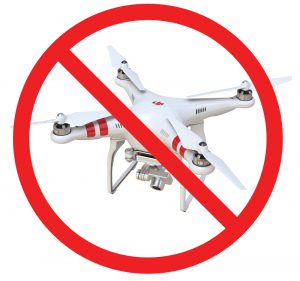 Arguably, Battelle’s DroneDefender anti-UAV rifle has generated the most buzz in the growing anti-drone sector. For example, the drone killer turned a lot of headlines at the Navy’s recent Sea-Air-Space exhibition. The rifle is billed as a man-portable, directed energy UAS countermeasure capable of disabling small drones using “radio control frequency disruption.”
Arguably, Battelle’s DroneDefender anti-UAV rifle has generated the most buzz in the growing anti-drone sector. For example, the drone killer turned a lot of headlines at the Navy’s recent Sea-Air-Space exhibition. The rifle is billed as a man-portable, directed energy UAS countermeasure capable of disabling small drones using “radio control frequency disruption.”
But Battelle is not the only game in town. As Ars Technica reports, California-based Flex Force created buzz of its own at the expo with the launch of another anti-drone gun (cue “Who Ya Gonna Call?” chant), Dronebuster.
Like the DroneDefender, Dronebuster deploys broadband signal jamming. Unlike Battelle’s weapon, Dronebuster is smaller and exploits weaknesses in a UAV’s internal protocols themselves, allowing a user to command a captured drone to fly back to its base or simply land wherever it is. This would allow a police force to gather data from the downed drone to locate its errant owner.
How does it capture drone signals? It works on the same principle as one of those universal remote controls. In short, the Dronebuster keeps trying various “command set” signals for a wide variety of drone systems in much the same way a universal remote searches RCA, Samsung or Sony codes).
Dronebuster users can find and stop drones using the systems unique “ears-and-eyes” approach – either via its onboard radio sign power meter/analyzer or direct optical sights.
Flex Force chief technology officer Jake Sullivan told Ars that the inspiration for the weapon stemmed from complaints of drones interference with firefighting efforts last year in California. His company hopes to market it to public safety agencies; however, Flex Force will have to modify the base model to conform to FCC regulations since jamming technologies are currently illegal. The firm hopes to soon release a Dronebuster update that will meet FCC requirements.
Dronebuster may find a willing customer in the federal government as well. Earlier this month, the FAA announced a Cooperative Research and Development Agreement with Gryphon Sensors, Liteye Systems and Sensofusion to deploy drone-sensor prototypes at select airports, an FAA press release stated. The agency emphasized it would work with other federal agencies – especially Homeland Security – to ensure the systems don’t interfere with normal aviation systems at area airports.
Jason is a longstanding contributor to DroneLife with an avid interest in all things tech. He focuses on anti-drone technologies and the public safety sector; police, fire, and search and rescue.
Beginning his career as a journalist in 1996, Jason has since written and edited thousands of engaging news articles, blog posts, press releases and online content.
Email Jason
TWITTER:@JasonPReagan
Subscribe to DroneLife here.







[…] the Navy’s recent Sea-Air-Space exhibition, Battelle’s DroneDefender anti-UAV rifle generated a lot of buzz as […]